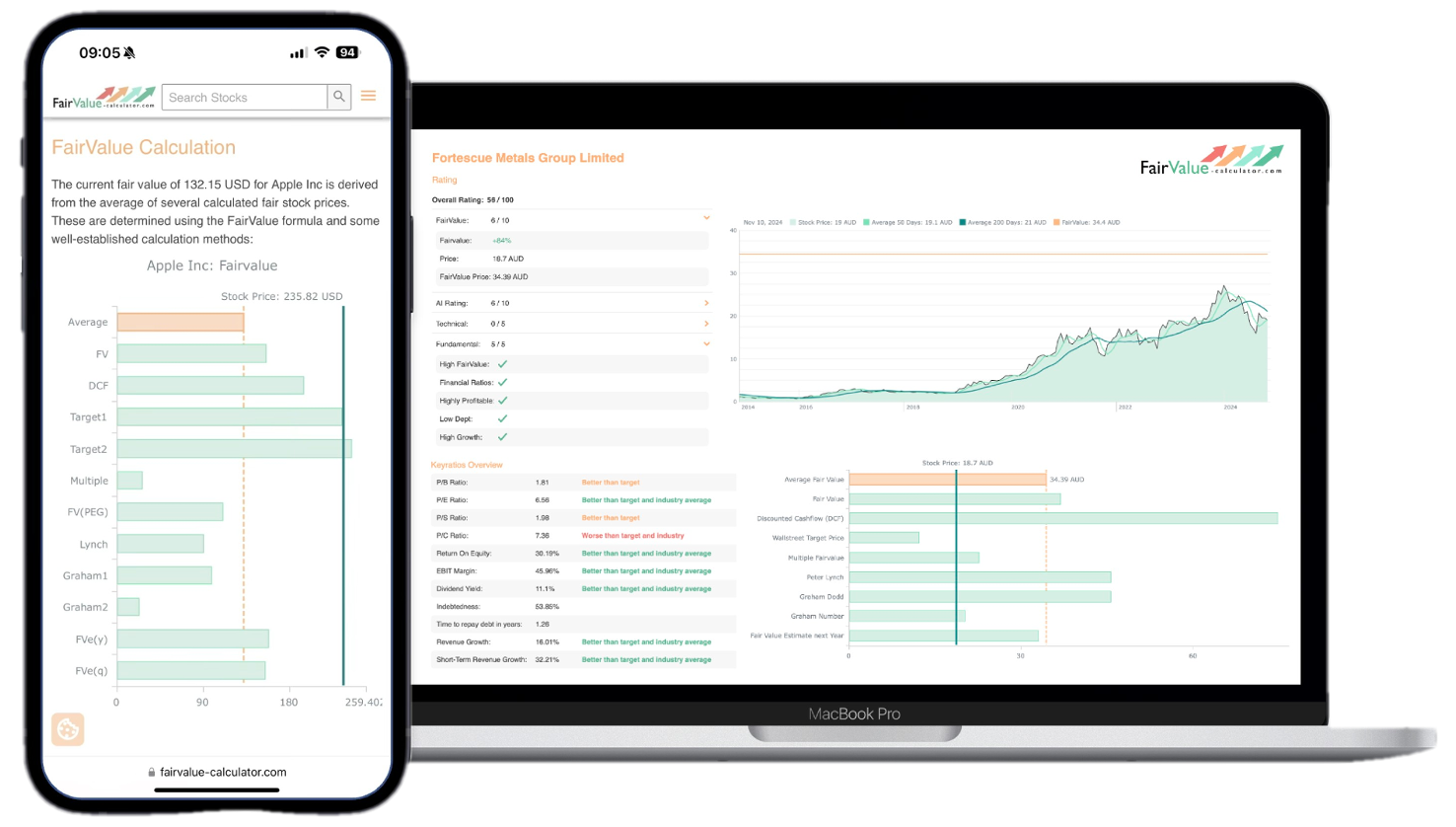Experienced investors are constantly seeking sophisticated methods to accurately estimate the fair value of assets. Advanced valuation techniques, such as Monte Carlo simulations and real options analysis, offer powerful tools to navigate the complexities of modern markets. This article delves into these methods, exploring their applications, benefits, and practical considerations for seasoned investors.
💡 Discover Powerful Investing Tools
Stop guessing – start investing with confidence. Our Fair Value Stock Calculators help you uncover hidden value in stocks using time-tested methods like Discounted Cash Flow (DCF), Benjamin Graham’s valuation principles, Peter Lynch’s PEG ratio, and our own AI-powered Super Fair Value formula. Designed for clarity, speed, and precision, these tools turn complex valuation models into simple, actionable insights – even for beginners.
Learn More About the Tools →🚀 Test the Fair Value Calculator Now!
Find out in seconds whether your stock is truly undervalued or overpriced – based on fundamentals and future growth.
Try it for Free →Understanding Monte Carlo Simulations
Monte Carlo simulations are a statistical technique used to model the probability of different outcomes in a process that cannot easily be predicted due to the intervention of random variables. In the context of investment valuation, these simulations help investors understand the range of potential future values of an asset by running multiple scenarios based on random sampling.
Explore our most popular stock fair value calculators to find opportunities where the market price is lower than the true value.
- Peter Lynch Fair Value – Combines growth with valuation using the PEG ratio. A favorite among growth investors.
- Buffett Intrinsic Value Calculator – Based on Warren Buffett’s long-term DCF approach to determine business value.
- Buffett Fair Value Model – Simplified version of his logic with margin of safety baked in.
- Graham & Dodd Fair Value – Uses conservative earnings-based valuation from classic value investing theory.
- Intrinsic vs. Extrinsic Value – Learn the core difference between what a company’s really worth and what others pay.
- Intrinsic Value Calculator – A general tool to estimate the true value of a stock, based on earnings potential.
- Fama-French Model – For advanced users: Quantifies expected return using size, value and market risk.
- Discount Rate Calculator – Helps estimate the proper rate to use in any DCF-based valuation model.
The benefits of Monte Carlo simulations include:
Risk Assessment: By simulating a wide range of possible outcomes, investors can better assess the risk associated with an investment. This is particularly useful in volatile markets, where traditional valuation methods may not capture the full spectrum of potential risks.
Scenario Analysis: This technique allows for the consideration of various market conditions and their potential impact on asset value. Investors can model best-case, worst-case, and most-likely scenarios to gain a comprehensive view of an investment’s potential.
Decision-Making: The insights gained from these simulations can inform more robust investment strategies and portfolio management decisions. For example, investors can identify optimal asset allocation strategies that balance risk and return.
Stress Testing: Monte Carlo simulations can be used to stress test portfolios under extreme market conditions, helping investors prepare for and mitigate potential losses.
Practical Implementation of Monte Carlo Methods
When implementing Monte Carlo simulations, investors should focus on several key technical considerations. The selection of probability distributions for key variables is crucial – normal distributions may be inappropriate for financial variables that exhibit skewness or fat tails. Log-normal distributions often better represent stock prices, while t-distributions can capture the heavy tails observed in return data.
The number of simulation runs significantly impacts accuracy. While 10,000 iterations might suffice for simple models, complex valuations may require 100,000 or more runs to achieve statistical significance. Investors should also implement variance reduction techniques such as antithetic variates or control variates to improve efficiency and reduce computational time.
Common Pitfalls and Limitations
Despite their power, Monte Carlo simulations have limitations that investors must acknowledge. Model risk arises when the underlying assumptions about variable relationships prove incorrect. Correlation structures between variables can be particularly challenging to model accurately, especially during market stress periods when correlations tend to increase.
Historical data used to calibrate simulations may not reflect future market conditions, particularly during structural breaks or regime changes. Additionally, Monte Carlo methods assume that the modeled relationships remain stable over time, which may not hold during periods of significant economic or regulatory change.
Real Options Analysis: Beyond Traditional Valuation
Real options analysis extends the principles of financial options to capital budgeting and investment decisions. Unlike traditional discounted cash flow (DCF) methods, real options analysis considers the flexibility and uncertainty inherent in investment opportunities.
Key aspects of real options analysis include:
Flexibility Valuation: This method accounts for the value of managerial flexibility, such as the option to delay, expand, or abandon a project. For instance, a company may have the option to delay a project until market conditions improve, enhancing the project’s overall value.
Uncertainty Management: Real options analysis is particularly useful in industries with high uncertainty, where traditional valuation methods may fall short. By incorporating uncertainty into the valuation process, investors can make more informed decisions that account for potential risks and rewards.
Strategic Decision-Making: By incorporating real options, investors can make more strategic decisions that maximize value over the long term. This approach is particularly valuable in industries with significant regulatory or technological uncertainty.
Competitive Advantage: Real options analysis can provide a competitive advantage by enabling investors to identify and capitalize on opportunities that may be overlooked by traditional valuation methods.
Types of Real Options
Understanding the various types of real options helps investors identify value-creating opportunities:
Expansion Options allow companies to increase the scale of operations when market conditions are favorable. Technology companies often possess valuable expansion options through their ability to scale software products with minimal marginal costs.
Abandonment Options provide the flexibility to exit a project early, limiting downside risk. This is particularly valuable in capital-intensive industries where sunk costs can be substantial.
Timing Options enable companies to delay investment until uncertainty resolves or market conditions improve. Pharmaceutical companies routinely exercise timing options when deciding whether to advance drug candidates through expensive clinical trials.
Switching Options allow companies to change inputs, outputs, or production methods based on changing market conditions. Energy companies often hold valuable switching options between different fuel sources or production technologies.
Growth Options represent opportunities for future expansion that depend on the success of current investments. Many venture capital investments are essentially purchases of growth options in emerging technologies or markets.
Valuation Models for Real Options
The Black-Scholes framework, while originally developed for financial options, can be adapted for real options valuation with modifications to account for dividends (representing cash flows from the underlying asset) and the lack of market trading.
Binomial and trinomial trees offer more flexibility for modeling complex real options with multiple decision points and path-dependent features. These lattice methods can accommodate changing volatility, multiple sources of uncertainty, and American-style exercise features common in real options.
For situations involving multiple interacting uncertainties, sophisticated numerical methods such as finite difference methods or partial differential equation approaches may be necessary.
Additional Advanced Valuation Techniques
Multi-Factor Models and Risk Decomposition
Beyond Monte Carlo and real options, sophisticated investors employ multi-factor models to decompose investment returns and risks. The Fama-French three-factor model extends the Capital Asset Pricing Model by incorporating size and value factors, while more recent five-factor models add profitability and investment factors.
These models help investors understand the sources of expected returns and construct portfolios that target specific risk factors.
Factor-based valuation is particularly valuable for:
- Risk Budgeting: Allocating risk across different systematic factors rather than individual assets
- Performance Attribution: Understanding whether returns come from factor exposure or security selection
- Style Analysis: Determining the implicit factor exposures in existing portfolios
Behavioral Finance Integration
Modern valuation increasingly incorporates behavioral finance insights to account for systematic biases in market pricing. Anchoring bias can cause valuations to stick to historical reference points, while overconfidence leads to excessive trading and mispricing.
Momentum and mean reversion patterns, partially explained by behavioral biases, can be incorporated into valuation models through regime-switching approaches or time-varying parameter models. This integration helps investors identify when traditional valuation metrics may be distorted by behavioral factors.
Alternative Data and Machine Learning
The proliferation of alternative data sources—satellite imagery, social media sentiment, credit card transactions, and web scraping—provides new inputs for valuation models. Machine learning techniques can process these large, unstructured datasets to extract pricing-relevant signals.
However, investors must be cautious about overfitting and the stability of machine learning-derived relationships. Cross-validation, out-of-sample testing, and regular model retraining are essential practices for maintaining robust valuation frameworks.
Integrating Advanced Techniques into Investment Strategies
To effectively integrate advanced valuation techniques into investment strategies, investors should consider the following:
Data Quality: The accuracy of these methods depends heavily on the quality of input data. Investors should ensure that they have access to reliable and comprehensive data sources.
Technological Tools: Leveraging specialized software and tools can enhance the efficiency and accuracy of these analyses. For example, financial modeling platforms and statistical analysis programs can streamline the valuation process.
Expertise: A deep understanding of statistical methods and financial theory is crucial for the effective application of these techniques. Investors may need to invest in training or consult with experts to develop the necessary skills.
Regulatory Considerations: Investors should be aware of any regulatory requirements or constraints that may impact the use of advanced valuation techniques.
Market Conditions: The choice of valuation technique may depend on market conditions. For instance, real options analysis may be more appropriate in volatile or uncertain markets, while Monte Carlo simulations can provide valuable insights in stable markets.
Building a Comprehensive Valuation Framework
Successful implementation requires integrating multiple valuation approaches rather than relying on any single method.
A robust framework might combine:
- Traditional DCF analysis as a baseline valuation
- Monte Carlo simulations to assess uncertainty and risk
- Real options analysis to capture strategic flexibility
- Factor models to understand systematic risk exposures
- Market-based multiples to gauge relative valuation
This multi-method approach provides cross-validation of valuation estimates and helps identify potential blind spots in any single technique.
Risk Management and Model Validation
Advanced valuation techniques require sophisticated risk management practices. Regular backtesting of valuation models against realized outcomes helps identify model drift and areas for improvement. Stress testing valuation models under extreme scenarios reveals potential vulnerabilities.
Model governance frameworks should include documentation of key assumptions, regular review of model performance, and clear escalation procedures when models produce unexpected results. Independent validation of complex models by parties not involved in their development helps maintain objectivity.
Practical Applications Across Asset Classes
Different asset classes benefit from specific advanced valuation approaches:
Equity Investments: Monte Carlo simulations excel at modeling earnings uncertainty, while real options analysis captures the value of corporate flexibility and growth opportunities.
Fixed Income: Advanced techniques help model credit risk, interest rate sensitivity, and embedded options in complex securities like mortgage-backed securities or callable bonds.
Alternative Investments: Private equity and venture capital investments often contain significant real options components, while real estate investments benefit from Monte Carlo analysis of rental income and property value scenarios.
Commodities: Real options frameworks are particularly valuable for natural resource investments, where extraction timing and capacity decisions create significant flexibility value.
Final Words
Advanced valuation techniques like Monte Carlo simulations and real options analysis offer experienced investors powerful tools to navigate the complexities of modern markets. By incorporating these methods into their investment strategies, investors can make more informed decisions, better manage risk, and identify opportunities for value creation.
The key to success lies not in choosing a single advanced technique, but in building a comprehensive valuation framework that combines multiple approaches while maintaining awareness of their limitations and assumptions. As markets continue to evolve and become more complex, investors who master these sophisticated valuation methods will be better positioned to generate superior risk-adjusted returns.
However, effectively implementing these techniques requires careful consideration of data quality, technological tools, expertise, and market conditions. The investment in developing these capabilities—whether through internal training, technology infrastructure, or external partnerships—represents a crucial competitive advantage in today’s increasingly sophisticated investment landscape.
Monte Carlo Simulation Calculator
FAQs
What are the benefits of using Monte Carlo simulations in valuation?
Monte Carlo simulations provide a comprehensive view of potential outcomes, helping investors assess risk, conduct scenario analysis, inform decision-making, and stress test portfolios.
How does real option analysis differ from traditional discounted cash flow methods?
Real options analysis considers the value of flexibility and uncertainty, whereas traditional DCF methods focus on expected cash flows and discount rates. This approach is particularly valuable in industries with high uncertainty.
What are the key considerations when implementing advanced valuation techniques?
Data quality, technological tools, expertise, regulatory requirements, and market conditions are key considerations.
Can these techniques be applied to all types of investments?
While these techniques are versatile, they are particularly valuable in situations with high uncertainty and where managerial flexibility is a significant factor.
What tools or software are commonly used for these advanced valuation methods?
Specialized software and tools, such as financial modeling platforms and statistical analysis programs, are commonly used to implement these techniques.








Peter
Clear and actionable insights! The ‘valuation traps’ section is a must-read for anyone relying on static models. Do you think these techniques adapt well to disruptive industries like AI or renewables?
Endrit Sina
Thank you so much for your feedback — I truly appreciate it! You’ve raised an excellent point regarding disruptive industries like AI and renewables. Advanced valuation techniques such as Monte Carlo simulations and real options analysis are particularly well-suited for these sectors, precisely because they account for high uncertainty, rapid technological change, and the need for strategic flexibility.
Real options analysis, for example, is especially valuable in industries like AI and renewables, where the ability to pivot, scale, or delay projects based on evolving market or regulatory conditions can significantly impact value. Similarly, Monte Carlo simulations can model a wide range of possible outcomes, making them powerful tools for stress-testing investment assumptions in these fast-changing environments.